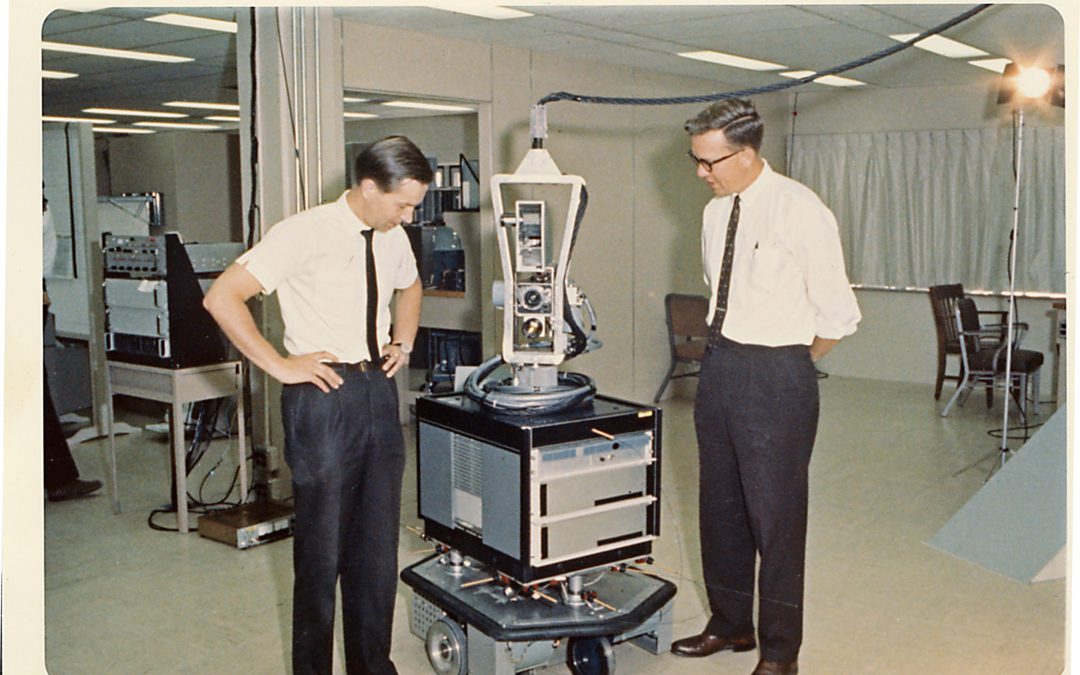Nils Nilsson and Sven Wahlstrom pictured with Shakey, the first humanoid. Photo courtesy of SRI International
By Karen Myers
“Hello! This is Nils Nilsson calling!!” Or so the booming voice on the other end of the line claimed, as I skeptically held the phone in my hand on a Sunday afternoon mid-way through my final semester as an undergraduate in Toronto. I had been in my dorm room preparing for a mid-term in my Introduction to Artificial Intelligence course, in fact reading through the textbook which Nils himself had authored. I was certain the call was a prank perpetrated by a classmate who knew I was anxiously awaiting word on whether I would be accepted to the PhD program at Stanford. But it turned out to be legitimate: Nils had recently taken on the role as Chair of the Computer Science department at Stanford and decided that he wanted to call all of the applicants that had been offered admission. He thought it would be a nice way to welcome the incoming students to the university.
Nils ended up as my PhD advisor at Stanford, in a turn of events for which I am tremendously grateful. I had expected, of course, that he would be a brilliant researcher with strong technical vision and an abundance of creative ideas; he certainly had all of those qualities. What I hadn’t anticipated was that he would be such a kind, generous, and inspirational individual. Despite all of the pressures that he faced in his role as department chair, he always made time for his students and did whatever he could to help them succeed in their research careers. At one point, he had amassed 18 students that he was advising – he simply didn’t have the heart to turn anyone down.
The field of Artificial Intelligence has strong allure for all of us in the community but Nils had a passion for the field that ran extremely deep. His love for AI kept him actively involved in the field long after retiring from Stanford. Even during the days of the AI Winter, he remained firmly committed to the belief that human ingenuity would enable us to create intelligent machines that would dazzle the world with their breadth and scope of capabilities. I remembered him warning his graduate students that we had better move quickly on our dissertations because he believed that major breakthroughs in AI were going to happen within five years and he didn’t want us to miss out. While his timing was off by a couple of decades, he was correct about the impact that the field would have. I’m so glad that he lived to see the extent of the AI revolution that has occurred in recent years.
Researchers are notorious for learning “more and more about less and less”. In contrast, Nils made seminal contributions in almost all areas of AI. He started his career working on neural networks, then progressed to ground-breaking work on search, automated planning, robotics, logic, and hybrid probabilistic/deductive inference, eventually landing on machine learning as the topic that fascinated him most late in his career. I recall him telling me right around the time I graduated that he thought machine learning was the key to success for AI and, in typical fashion, he dove headlong into exploring its use to achieve his vision for intelligent robots.
The great outdoors was a second passion for Nils. He particularly loved to spend time at Lake Tahoe, frequently visiting a cabin that his family had co-owned with close friends for decades. We used to tease him about the frequency with which our Monday research meetings had to be cancelled during the winter because he had gotten snowed in yet again, leaving him no option but to spend another day skiing. Every Spring Break he invited his students to join him at the cabin for a few days. He was an expert skier but graciously passed on his favorite Black Diamond runs to help the novices navigate their way down the bunny slopes. His former students have many fond memories of the cheery evening meals prepared and shared together after our exertions on the slopes.
Nils deservedly was awarded every major accolade in the field, serving as a testament to his outstanding technical leadership and impact. I think what is even more special about him is how deeply he affected people on a personal level. His enthusiasm was infectious and provided a level of optimism and energy that propagated readily to those nearby. His students and colleagues at both Stanford and SRI adored him. Almost without fail, the mention of his name brings a smile to people’s faces and often a wonderful story about some interesting shared experience or exchange with him. While he is deeply missed, I’ll be forever grateful for the many wonderful memories and the inspirational mentorship that he provided.
